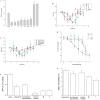2-MeS-beta,gamma-CCl2-ATP is a potent agent for reducing intraocular pressure
- PMID: 20337495
- PMCID: PMC4358770
- DOI: 10.1021/jm100030u
2-MeS-beta,gamma-CCl2-ATP is a potent agent for reducing intraocular pressure
Abstract
Extracellular nucleotides can modify the production or drainage of the aqueous humor via activation of P2 receptors and therefore affect the intraocular pressure (IOP). We have synthesized slowly hydrolyzable nucleoside di- and triphosphate analogues, 1, and 8-14. Analogues 8-14 were completely resistant to hydrolysis by alkaline phosphatase over 30 min at 37 degrees C. In human blood serum, analogues 8-14 exhibited high stability, e.g., analogues 9 and 10-14 were only 15% and 0% degraded after 24 h, respectively. Moreover, analogues 8-14 were highly stable at pH 1.4 (t(1/2) 1 h-30 days). Analogues 8-14 were agonists of the P2Y(1) receptor (EC(50) 0.57-9.54 muM). Ocular administration of most analogues into rabbits reduced IOP, e.g., analogue 9 reduced IOP by 32% (EC(50) 95.5 nM). Analogue 9 was more effective at reducing IOP than several common glaucoma drugs and represents a promising alternative to timolol maleate, which cannot be used for the treatment of patients suffering from asthma or cardiac problems.
Figures








Similar articles
-
Identification of hydrolytically stable and selective P2Y(1) receptor agonists.Eur J Med Chem. 2009 Apr;44(4):1525-36. doi: 10.1016/j.ejmech.2008.07.015. Epub 2008 Jul 22. Eur J Med Chem. 2009. PMID: 18760862 Free PMC article.
-
Adenine nucleotide analogues locked in a Northern methanocarba conformation: enhanced stability and potency as P2Y(1) receptor agonists.J Med Chem. 2002 May 9;45(10):2090-100. doi: 10.1021/jm010538v. J Med Chem. 2002. PMID: 11985476 Free PMC article.
-
A novel insulin secretagogue based on a dinucleoside polyphosphate scaffold.J Med Chem. 2010 Mar 25;53(6):2472-81. doi: 10.1021/jm901621h. J Med Chem. 2010. PMID: 20175517 Free PMC article.
-
Adenosine 5'-O-(1-boranotriphosphate) derivatives as novel P2Y(1) receptor agonists.J Med Chem. 2002 Nov 21;45(24):5384-96. doi: 10.1021/jm020251d. J Med Chem. 2002. PMID: 12431066
-
Synthesis and P2Y receptor activity of nucleoside 5'-phosphonate derivatives.Bioorg Med Chem Lett. 2009 Jun 1;19(11):3002-5. doi: 10.1016/j.bmcl.2009.04.027. Epub 2009 Apr 14. Bioorg Med Chem Lett. 2009. PMID: 19419868 Free PMC article.
Cited by
-
P2Y receptors in the mammalian nervous system: pharmacology, ligands and therapeutic potential.CNS Neurol Disord Drug Targets. 2012 Sep;11(6):722-38. doi: 10.2174/187152712803581047. CNS Neurol Disord Drug Targets. 2012. PMID: 22963441 Free PMC article. Review.
-
Adenine: an important drug scaffold for the design of antiviral agents.Acta Pharm Sin B. 2015 Sep;5(5):431-41. doi: 10.1016/j.apsb.2015.07.002. Epub 2015 Sep 2. Acta Pharm Sin B. 2015. PMID: 26579473 Free PMC article. Review.
-
Purinergic dysregulation causes hypertensive glaucoma-like optic neuropathy.JCI Insight. 2017 Oct 5;2(19):e93456. doi: 10.1172/jci.insight.93456. JCI Insight. 2017. PMID: 28978804 Free PMC article.
-
Pharmacochemistry of the platelet purinergic receptors.Purinergic Signal. 2011 Sep;7(3):305-24. doi: 10.1007/s11302-011-9216-0. Epub 2011 Feb 18. Purinergic Signal. 2011. PMID: 21484092 Free PMC article.
-
Overview of Biologically Active Nucleoside Phosphonates.Front Chem. 2021 Jan 8;8:616863. doi: 10.3389/fchem.2020.616863. eCollection 2020. Front Chem. 2021. PMID: 33490040 Free PMC article. Review.
References
-
- Williams M, Jarvis MF. Purinergic and pyrimidinergic receptors as potential drug targets. Biochem Pharmacol. 2000;59:1173–1185. - PubMed
-
- Guile SD, Ince F, Ingall AH, Kindon ND, Meghani P, Mortimore MP. The medicinal chemistry of the P2 receptor family. Prog Med Chem. 2001;38:115–187. - PubMed
-
- Fischer B. Therapeutic applications of ATP-(P2)-receptors agonists and antagonists. Expert Opin Ther Pat. 1999;9:385–399.
-
- Hillmann P, Ko GY, Spinrath A, Raulf A, von Kugelgen I, Wolff SC, Nicholas RA, Kostenis E, Holtje HD, Muller CE. Key Determinants of nucleotide-activated G protein-coupled P2Y2 receptor function revealed by chemical and pharmacological experiments, mutagenesis and homology modeling. J Med Chem. 2009;52:2762–2775. - PubMed
-
- Burnstock G, Verkhratsky A. Evolutionary origins of the purinergic signalling system. Acta Physiol. 2009;195:415–447. - PubMed
Publication types
MeSH terms
Substances
Grants and funding
LinkOut - more resources
Full Text Sources
Other Literature Sources
Chemical Information
Miscellaneous

